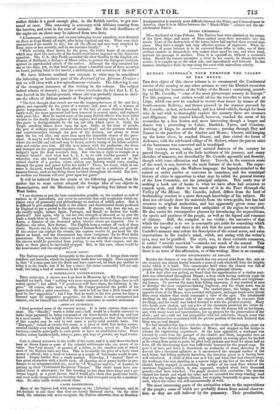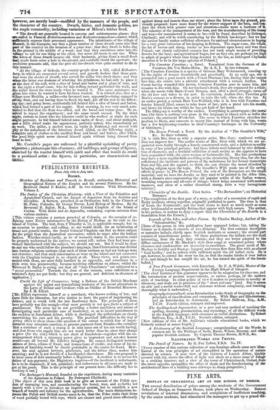DUDLEY' COSTELLO'S TOUR THROUGH THE VALLEY OF THE MEUSE.
THE first object of this clever volume is to recommend the Continental tourist of the ensuing or any other autumn to vary his Rhenish excursion by exploring the beauties of the Valley of the Meuse ; containing, accord- ing to Mr. Costello, " some of the most picturesque scenery in Europe." For this purpose, our author would advise the traveller to turn aside at Liege, which can now be reached in twenty-four hours by means of the South-eastern Railway, and thence proceed in the manner pursued by Mr. Costello, on foot, on horseback, and in a hired vehicle, though for those who do not wish to thoroughly explore the country there are steamers and diligences. Our tourist himself; however, reached the scene of his researches by a less beaten and more interesting though a longer and dearer way ; proceeding to Calais, Dunkirk, Ypres, and Courtray. Arriving at Liege, he ascended the stream ; passing through Huy and Namur to the junction of the Sambre and Meuse; whence, still keeping up the latter river, he reached Dinant, and then visited the forest of Ardennes, with the celebrated village of St. Hubert, where the patron saint of the huntsman was converted and is worshiped.
The various towns, ruins, and natural features of the country he passed through, as well as the little incidents of his journey, and many sketches of manners are described by Mr. Costello agreeably and fluently, though with some affectation and finery. Travels, in the common sense of the word, is not, however, the main feature of the book. The super- stitions of the people, the Walloon language, the legends attached to the ruined or entire castles or convents he examines, and the municipal history of cities in opposition to what may be called the general history of the Low Countries, are his principal subjects. This ready way of making a book out of books is what we have often had occasion to remark upon, and there is too much of it in the Tour through the Valley of the Meuse. Mr. Costello' indeed, differs from the herd of bookmaking tourists in a more thorough knowledge of his subject. He does not obviously draw his materials from the town-guide, but has had recourse to original authorities, and has apparently given some pre- liminary study to the history and antiquities of the region he explored. He also varies his retrospective glances by introducing the superstitions, the sports and pastimes of the people, as well as the legend and romance of history. Still, the compiler is too visible : the narrative of that which the traveller is to see is constantly put aside for something which exists no longer ; and there is the risk that the past association in Mr. Costello's memory may colour his description of the actual scene, and raise expectations in the reader's mind, which, not seeing with the writer's eyes, may not be gratified. The style, too, in these veritable romances, is rather "sweetly mawkish "—smacks too much of the annual. This is the more visible because in the passages that refer to real travelling there is no trace of this affectation, or of fine writing. Here is an example.
RUSTIC ENGINEERING AT DINANT.
Besides the chances of war the church has run several risks from fire, and on one occasion was almost buried beneath a mass of rock which fell from the heights under which it is built. This catastrophe befel when the church was full tf people, during the funeral ceremony of one of the principal citizens. A few days after our arrival, we found that the apprehension of a similar acci, dent was entertained throughout Dinant; a deep crack having suddenly made its appearance on the surface of the rock, impending over the church and neighbour- ing houses. To prevent the mass from falling unawares, it was resolved at once to dislodge the most suspicious-looking fragment; and the whole town was in commotion to witness the operation. The market-place, the bridge, and the opposite shore of the Meuse, were crowded withgazers andeager heads were thrust from every window that could command a view d the spot. The inhabitants dwelling on the dangerous side of the church were obliged to evacuate their dwellings, and the result was looked forward to with the greatest anxiety. Many wise heads were shaken, and not a few of the alarmists predicted the entire de- struction of the church and buildings adjacent. One old woman fell on her knees; and, with many tears and lamentations, put up prayers for the preservation of her abode and one could not but sympathize with her solicitude, though some who professed themselves acquainted with the precise position of the rock declared that there was no real danger. We had intended that day to visit the ruins of the castle of Montaigle, about six miles off, in the district Entre Sambre et Meuse, and stopped on the bridge to witness the engineering experiment. At the hour appointed, a workman was lowered by cords from the parapet of time citadel; and there, suspended over an abyss some three hundred feet deep, with apparently no resting-place for his foot as he swung from point to point, he plied both pickaxe and lever for about half an hour, till the threatening mass was sufficiently loosened for the grand coup. He gave it at last; and down it thundered, an avalanche of stone, shivering in its descent into a thousand splinters as it encountered the unequal surface of the rock below' but falling perfectly harmless: the direction given to it having been well calculated. A cloud of dust rose as it fell; and when that had cleared away, the workman was seen standing on a narrow ledge at the foot of the walls of the citadel, busily engaged in smoothing the surface of the rock from whence the enormous fragment—which, it was supposed, weighed about forty thousand pounds—had been detached. The people shouted with exultation; the devotee clasped her hands and wiped her eyes; and we ascended the steep winding road that led to the heights opposite Dinant, but stopping frequently to gaze upon the rock, where the miner was still unconcernedly at work.
The most interesting parts of the antiquities relate to the superstitions of the people; some of which are probably drawn from actual observa- tion, as they are still believed by the peasantry. Their peculiarities,
however, are merely local—modified by the manners of the people, and the character of the country. Dwarfs, fairies, and domestic goblins, are the staple commodity, including variations of Milton's lubber fiend.
"The dwarfs are generally located in caverns and imbterranams places: they 411tegmlled in Flemish Halvermannekens and Kaboutermannekens—names which sufficiently express their presumed appearance. The inhabitants of the village of Bassett, in the Campine, say that a great number of these dwarfs came into that part of the country on the occasion of a great war-' that they dwelt in holes dug an the ground in the middle of a wood; and that they sometimes came into the village to ask for one thing or the other, but never did harm to any one. When tie wives of these dwarfs became old, dick husbands, giving them a small fresh loaf made them enter a bole in the ground, and carefully closed the aperture: the credulous peasants add, that the poor old she-dwarfs were quite content to die in this manner.
"At the village of Gelrode, the country-people show a hill, called Kabouter- berg, in which are excavated several caves, and gravely declare that these grot- toes were the abodes of dwarfs, who served the miller who dwelt there; and that *hen the latter was desirous of whetting his grindstone, he had only to place it At the door of his mill, with a slice of bread and butter and a glass of beer, and in the night a dwarf came' who for this trifling reward performed the work, and the miller found the stone ready when he wanted it. The same assistance was given him when he wanted to have his linen washed. It is related also, that at a village near Mechlin, a miller—the favoured race, apparently—being engaged in sifting flour, and not having time to finish his task, put off the rest to the follow- ing ; and going home, accidentally left behind him a slice of bread and butter, which had formed a part of his supper. Next morning, he was very much &sla- in-shed to find that the flour was sifted, and the bread and butter gone. He re- solved to repeat the experiment; and the same result ensued. On the third -night, curious to know who the labourer could be who worked at night for such slight payment, be bid himself behind some sacks of flour-' and about midnight, *taw a little dwarf make his appearance, perfectly naked, who immediately set to work. The miller, a modest man, (a rarity in Brabant,) and moved with lily at the nakedness of the laborious dwarf, added, on the following night, a complete suit of clothes to the nnsifted flour and bread and butter; after which, the good little spirit never showed himself again without being dressed from head to foot."
Mr. Costello's pages are enlivened by a plentiful sprinkling of pretty 'vignettes ; picturesque bits of scenery, old buildings, and groups of figures, nizetched by the tourist himself with spirit and effect that would do credit to a professed artist : the figures, in particular, are characteristic and lifelike.



























 Previous page
Previous page